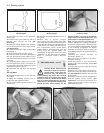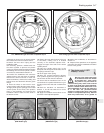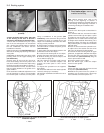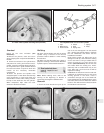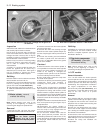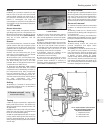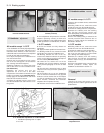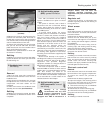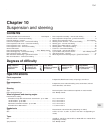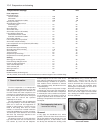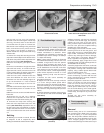
Inspection
4 Brush the dust and dirt from the brake drum
and carefully inspect the drum interior.
5 If the drum is grooved, owing to failure to
renew worn brake shoes or after a very high
mileage has been covered, then it may be
possible to regrind it, provided the maximum
internal diameter is not exceeded.
6 Even if only one drum is in need of grinding
both drums must be reground to the same
size in order to maintain even braking
characteristics.
7 Judder or a springy pedal felt when the
brakes are applied can be caused by a
distorted (out-of-round) drum. Here again it
may be possible to regrind the drums,
otherwise a new drum will be required.
Refitting
8 Fit the hub/drum on the stub axle and retain
with the washer and new hub nut.
9 Tighten the nut to the specified torque then
lock it by staking the nut flange into the
groove on the stub axle (see illustration).
10 Tap the grease cap into the hub/drum.
11 Refit the roadwheels and lower the car to
the ground.
12 Master cylinder - removal,
overhaul and refitting
3
Note: Before starting work, refer to the
warning at the beginning of Section 2
concerning the dangers of hydraulic fluid.
Removal
1 Unscrew the filler cap from the master
cylinder fluid reservoir and drain off the fluid.
2 Prise the reservoir from the master cylinder
and remove the seals.
3 Unscrew the union nuts securing the rigid
brake lines to the master cylinder and pull out
the lines. Cap the pipe ends to prevent loss of
fluid.
4 Unscrew the mounting nuts and withdraw
the master cylinder from the bulkhead or
servo unit, as applicable. Remove the gasket
on non-servo models.
Overhaul
5 Clean the exterior of the master cylinder. It
is not possible to overhaul the master cylinder
fitted to non-servo models, therefore if it is
known to be leaking or damaged the
complete master cylinder must be renewed.
On servo models proceed as follows.
6 Using circlip pliers, extract the circlip from
the mouth of the cylinder.
7 Remove the primary and secondary piston
components noting their locations. If
necessary tap the cylinder on a block of
wood.
8 Clean all the components in methylated
spirit. Check the surfaces of the cylinder bore
and pistons for scoring and corrosion, and if
evident renew the complete master cylinder. If
the components are in good condition remove
and discard the seals and obtain a repair kit
which will contain all the necessary renewable
components.
9 Dip the new seals in fresh brake fluid and fit
them to the pistons using the fingers only to
manipulate them.
10 Reassemble the master cylinder in
reverse order to dismantling and make sure
that the circlip is fully engaged with the
groove in the mouth of the cylinder.
11 On non-servo models check that the
brake pedal pushrod protrudes from the
bulkhead by between 9.0 and 9.6 mm. If not,
loosen the locknuts and adjust the position of
the stop light switch inside the car on the
pedal bracket.
Refitting
12 Refitting is a reversal of removal, but fit a
new gasket on non-servo models. Finally
bleed the complete hydraulic system, as
described in Section 2.
13 Rear brake compensator
(GTI models) - information,
removal and refitting
2
Note: Before starting work, refer to the
warning at the beginning of Section 2
concerning the dangers of hydraulic fluid.
1.6 GTI models
General information
1 On 1.6 GTI models the brake hydraulic
circuit is split front-to-rear, and an inertia type
compensator is incorporated in the rear brake
circuit to prevent rear wheel lock-up during
hard braking. The compensator is located in
the engine compartment on the lower
left-hand side panel (see illustration), and
incorporates a steel ball which stops fluid
entry to the rear circuit at a preset
deceleration.
Removal
2 To minimise fluid loss, unscrew the master
cylinder reservoir filler cap and place a piece
of polythene over the filler neck. Secure the
polythene with an elastic band ensuring that
an airtight seal is obtained.
3 Chock the rear wheels then jack up the
front of the car and support it on axle stands
(see “Jacking and vehicle support”). Remove
the relevant front roadwheel.
4 Unscrew the union nuts and disconnect the
rigid hydraulic lines from each end of the unit
while holding the unit on the flats provided.
5 Unbolt the clamp and withdraw the
compensator.
9•12 Braking system
11.9 Lock the hub nut by staking the nut flange into the groove on
the stub axle
13.1 Rear brake compensator fitted to 1.6 GTI models
An ideal way to remove fluid
from the master cylinder
reservoir is to use a clean
syringe or an old poultry baster.





